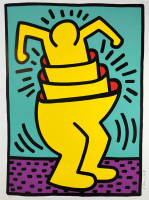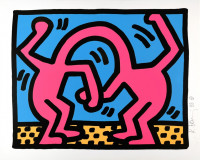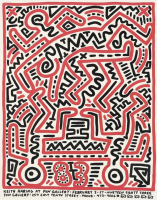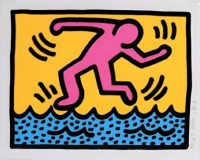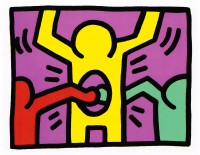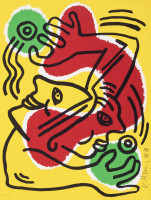
Details
Artist
Styles
Published by George Mulder Fine Art London -Suite of The Valley -Original etching on wove paper -Hand signed by the artist // Keith Haring’s Untitled IV from the Valley (1989) is an etching that combines his characteristic cartoon-like figures with thought-provoking, socially charged imagery. In this piece, a figure in a protective hazmat suit, marked with CDC (Centers for Disease Control) symbols, interacts with a vulnerable, exposed human figure, possibly alluding to issues of medical intervention, surveillance, or vulnerability in the face of institutional power. The simplified lines and bold outlines amplify the tension in the interaction, as Haring’s style emphasizes the psychological distance between the figures. Hand-signed by the artist, this etching reflects Haring’s ongoing engagement with themes of health, humanity, and authority, presented with his unique blend of simplicity and depth.
Untitled IV from the Valley, 1989
form
Medium
Size
35.6 x 31.8 cm
- Inches
- Centimeters
Edition
Price
Details
Artist
Styles
Published by George Mulder Fine Art London -Suite of The Valley -Original etching on wove paper -Hand signed by the artist // Keith Haring’s Untitled IV from the Valley (1989) is an etching that combines his characteristic cartoon-like figures with thought-provoking, socially charged imagery. In this piece, a figure in a protective hazmat suit, marked with CDC (Centers for Disease Control) symbols, interacts with a vulnerable, exposed human figure, possibly alluding to issues of medical intervention, surveillance, or vulnerability in the face of institutional power. The simplified lines and bold outlines amplify the tension in the interaction, as Haring’s style emphasizes the psychological distance between the figures. Hand-signed by the artist, this etching reflects Haring’s ongoing engagement with themes of health, humanity, and authority, presented with his unique blend of simplicity and depth.
- Recently Added
- Price (low-high )
- Price (high-low )
- Year (low-high )
- Year (high-low )
Keith Haring
Untitled (Plate 16) From The Blueprint Drawings, 1990
Limited Edition Print
Screen-print
USD 35,000 - 45,000
Keith Haring
Untitled (Plate 17) From The Blueprint Drawings, 1990
Limited Edition Print
Screen-print
USD 35,000 - 45,000
Keith Haring
Three Lithographs: One Plate, 1985
Limited Edition Print
Lithograph
USD 30,000 - 40,000
Keith Haring
Poster For Nuclear Disarmament, 1982
Limited Edition Print
Offset Print
Inquire For Price
Keith Haring
Untitled (w/ Sean Kalish) - Set, 1989
Limited Edition Print
Etching
USD 35,000 - 45,000
Keith Haring
New Year's Invitation '88 (Nude) (TP), 1988
Limited Edition Print
Screen-print
USD 8,500
Keith Haring
White Icons (C) - Winged Angel, 1990
Limited Edition Print
Embossing
USD 15,000 - 20,000
Keith Haring
Untitled 1 (from Free South Africa), 1985
Limited Edition Print
Lithograph
Inquire For Price
Keith Haring
Untitled (Free South Africa), 1985
Limited Edition Print
Lithograph
USD 90,000 - 100,000
Keith Haring
White Icons (A) - Radiant Baby, 1990
Limited Edition Print
Embossing
USD 20,000 - 25,000
Keith Haring
Untitled - Scissors (from Pop Shop III), 1989
Limited Edition Print
Screen-print
Currently Not Available
Keith Haring
Untitled (Man On Dolphin), 1987
Limited Edition Print
Lithograph
Currently Not Available
What is graffiti art?
Graffiti art refers to drawings and writings that are painted, scratched, or scribbled on walls or other surfaces, typically in public spaces. This art form ranges from small tags to elaborate wall paintings. Graffiti has been in existence since ancient times, with examples dating back to the Roman Empire, Ancient Greece, and Ancient Egypt.



